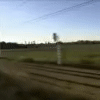|
NoWake posted:Fortunately, main lines are tested continuously by companies like Sperry which has ultrasonic equipment that would pick up a crack well before it got to the stage like you see in the picture. If any cracks are found, depending on the type of crack and severity, the tracks are slow ordered or put out of service until the rail is replaced. Private tracks, especially industrial sidings with low speeds, I doubt they get much more than a visual check every quarter or so. The base and the web at the break are pretty rusted, so that crack had been progressing for quite a while. Bull loving poo poo. Not the testing part. All true. Our railroad uses the FRA detector car, one of its own, plus contractors as backup. Bullshit because it does NOT stop the breaks. When it gets really cold at night after a nice day, or during an arctic snap, the rail snaps with it. Hundreds of breaks on even the busiest routes.
|
|
|
|

|
| # ? May 11, 2024 20:21 |
|
One man crews? Here is the railcar version of that logic 
|
|
|
|
Broken rails mean $$$$ for every one. Its a 4 hour affair on a single main line.
|
|
|
|
B4Ctom1 posted:One man crews? Saudi teenagers have really stepped up their game.
|
|
|
|
Slung Blade posted:Saudi teenagers have really stepped up their game. I'm glad that someone else saw this and thought "man, that's a serious drift".
|
|
|
|
Pigsfeet on Rye posted:I'm glad that someone else saw this and thought "man, that's a serious drift". I do believe he was referring to this: https://www.youtube.com/watch?v=MQm5BnhTBEQ
|
|
|
|
B4Ctom1 posted:One man crews? Sorry, with my railway management hat* on, I'm looking at 1/2 the rolling resistance and 1/2 the trackwear. How can the unions possibly not be on-board with this new development? Because they hate freedom and the economy, that's why. *: earned through Transport tycoon. Where I built roads instead.
|
|
|
|
I am glad to see we have finally one-upped the Saudis. Going to be difficult changing the wheels though seeing as there is only one Arnold. https://www.youtube.com/watch?v=Z38itkVtEqI
|
|
|
|
Disgruntled Bovine posted:I do believe he was referring to this: Correct.
|
|
|
|
 Avalanches kinda own. As long as they don't get too big!
|
|
|
|
So when a train derails a ways back from the engines, what alerts the engineer to it? Do alarms go off? Does the engine suddenly get balky and lsuggish? Just curious. Hopefully none of the train folks here were around this. http://chicago.suntimes.com/nationworld/7/71/417253/bnsf-train-carrying-crude-oil-derails-galena
|
|
|
|
The air "dumps" and your brought to a screeching halt.
|
|
|
quote:The ruptures and fires have prompted the administration of President Barack Obama to consider requiring upgrades such as thicker tanks, shields to prevent tankers from crumpling, rollover protections and electronic brakes that could make cars stop simultaneously, rather than slam into each other. but not a pipeline lol
|
|
|
|
|
MassivelyBuckNegro posted:but not a pipeline lol Well, you know those electronic brakes are SSSSOOOOO reliable  Before any one says anything, electronic brakes require maintenance. The railroads absolutely detest maintaining anything unless it slows the money, at which point they will throw every dollar known to man at it. These places make no sense.
|
|
|
|
Black and white. I have 4 stones and I will not tolerate this bullshit, but I need to swap out the best of luck to all of your life.
|
|
|
|
THE PENETRATOR posted:Black and white. I have 4 stones and I will not tolerate this bullshit, but I need to swap out the best of luck to all of your life. Right now, an FSB agent that just read this is digging up the large secret supply barrel in his backyard.
|
|
|
|
BrokenKnucklez posted:Well, you know those electronic brakes are SSSSOOOOO reliable Glad you fuckers are having the same fun as we are.
|
|
|
|
HD Drone footage of VA oil train aftermath https://www.youtube.com/watch?v=j8kONLIWlBs
|
|
|
|
Pigsfeet on Rye posted:So when a train derails a ways back from the engines, what alerts the engineer to it? Do alarms go off? Does the engine suddenly get balky and lsuggish? Just curious. Hopefully none of the train folks here were around this. Just as others have said, the air dumps and it stops. The train has a "brake pipe" that runs from the locomotives to all the cars and either to a rear end telemetry device or a rear locomotive. It is coupled with glad hands. If the cars derail the hoses are low enough that they will hit the ground, rail, ties, whatever and open the pipe's continuity "dumping" the air charge within. This rapid loss of air in the brake pipe triggers emergency valving in each car applying it's brakes via a reservoir tank on each and every car and even the locomotives. Here is a nice look at the hoses being coupled. Note how the trainman opens the valve to the new part of the train gently and slowly. He is opening the "angle cock" valve to send the air to the new portion of the train. If done too rapidly it could cause all the cars to mistakenly sense an emergency reduction in pressure causing them to "go into emergency" in a chain reaction. https://www.youtube.com/watch?v=bOM5P0Lr4oM Once in emergency, to recover first you need a solid sealed brake pipe. Then a release and recovery which is simply a repressurization. We are careful because it is time consuming depending on the amount of cars being handled. Coupling cars and also sections of cars to your train is simply a matter of a basic patient skill, workmanship, pride, and attention to detail. I don't know how they do it in Canada (like in the video) but reaching over a knuckle to cut in an angle cock is a huge punishable no-no offense on the UPRR because of the risk of death or serious bodily harm. for more info read about the Westinghouse Air Brake here: https://en.wikipedia.org/wiki/Railway_air_brake
|
|
|
|
B4Ctom1 posted:HD Drone footage of VA oil train aftermath Funny thing about that (besides Lynchburg trying to make itself into the Cleveland of the South) is that just a day before a friend and I had stopped for lunch at the Depot Grille there on the left on our way back north, and I had parked at the end of that line of cars you see in the parking lot. It would have been a very different drive home had we stopped there the day after as we had initially planned!
|
|
|
|
Train hits car somewhere in Kentucky (warning: you see it pretty drat well*): http://www.liveleak.com/view?i=616_1426435652 * The reason you see it pretty drat well is because it was some railfans who inadvertantly filmed it (from TWO angles).
|
|
|
|
bytebark posted:Train hits car somewhere in Kentucky (warning: you see it pretty drat well*): http://www.liveleak.com/view?i=616_1426435652 At first I thought the lights weren't flashing, but they are just faint in the video.
|
|
|
|
Followed this thing around a few nights ago, interesting bit of kit
|
|
|
|
bytebark posted:Train hits car somewhere in Kentucky (warning: you see it pretty drat well*): http://www.liveleak.com/view?i=616_1426435652 Dude, what a buzz kill. Those railfans were out just having fun and had to watch two people die due to the driver's impatience. That blows.
|
|
|
|
Tex Avery posted:Dude, what a buzz kill. Those railfans were out just having fun and had to watch two people die due to the driver's impatience I duno. Seems to me that they were just oblivious, not impatient. Same result, though.
|
|
|
|
In more news of interactions between trains and stupidity, a personal trainer decided to skip rope beside a train track for a video. He misjudged the width of the train. http://www.usatoday.com/story/news/nation/2015/03/19/personal-trainer-killed-train-shooting-youtube-video/25007365/
|
|
|
|
This morning I was biking to work along the LRT tracks and I watched a construction worker (whom I see cross the tracks every morning) lazily waltz in front of an oncoming train that was going 45mph. He seemed unconcerned, and did not speed his pace up at all. The train came within 20 feet of hitting him. People are so goddamned stupid, it makes me want to cry.
|
|
|
|
Pigsfeet on Rye posted:In more news of interactions between trains and stupidity, a personal trainer decided to skip rope beside a train track for a video. He misjudged the width of the train. I vaguely remember a very similar incidident. Guy making a video of himself working out near tracks. I can't google it, I just find more of the above dude.
|
|
|
|
Stick Insect posted:I vaguely remember a very similar incidident. Guy making a video of himself working out near tracks. I can't google it, I just find more of the above dude. http://www.latimes.com/local/lanow/la-me-ln-gregory-plitt-killed-train-superman-20150119-story.html This was only two months ago in LA. Seems like Brad Pitt's character in Burn After Reading was a pretty accurate portrayal.
|
|
|
|
I made this for us all
|
|
|
|
^^^ I approve of this, though in the UK we don't have a Toot Tooter, we have a Point and Tooty Honky Hooty. I've not done one of these for a while... Crap British Trains - The British Rail Class 58 If the passenger sectors of British Rail endured a dismal period of under-investment in the 1970s, the freight sector suffered just as much. Significant errors in locomotive procurement in the 1950s and 1960s had left BR with a surfeit of underpowered locomotives, and the Railfreight division was left with only one locomotive type with more than 2000 horsepower on tap – the mixed-traffic, 2580Hp Class 47, built from 1965 (it was originally designed to produce 2750Hp but their engines kept disintegrating and had to have their RPM limited). Because the same boneheads were also responsible for the 47’s procurement, it lacked that most basic of diesel locomotive features, the ability to work in multiple with other locos. But why would you need more than 2500Hp for a freight train anyway, right? This was at a time when operators in Europe and North America were running trains that needed 10,000Hp or more to haul, but Johnny Foreigner wasn’t going to tell us what to do! Brush Traction (who built the 47) did actually produce a prototype called Kestrel, which put out a whopping 4000Hp, went 110mph and blew away anything BR (or almost anyone else) could put on the tracks, but the British government decided that it sounded a bit too foreign and sold it to the Soviet Union, because gently caress you, that’s why.  Round here, comrade, actual good locomotives get SENT TO SIBERIA because that poo poo's unpatriotic The result was that English Electric’s long-suffering 1961-vintage 1750Hp Class 37 design was used as a heavy-freight workhorse in a way that it was never designed for, double or even triple-heading trains and often failing under the strain. By the 1970s it was clear that this would not do and that heavier and heavier trains, especially coal and other mineral loads, would require 6000Hp or even more to haul, and soon. So in 1975 BR blew the dust off their chequebooks and reluctantly ordered a class of heavy freight locos that was entirely made up of existing bits and pieces that they had lying around. They used the Class 47’s bodyshell, incorporating a development of the Class 50’s engine and the supercharger developed for the HST. The result was the 3250Hp Class 56. So bad was the penny-pinching that, in a continuation of involving murderous Communist dictators in our railways, construction of the first 30 units was subcontracted to Ceaucescu’s Romania. Oddly, these locos proved less than reliable and were soon on the scrapheap – much like Ceaucescu himself.  With locos built by slave labour you don't get the problem that the ones built on Fridays aren't as good The Class 56 was at long last powerful enough, but it was not especially reliable and despite the miserly nature of its design and procurement it proved expensive to build and maintain. It was also based on a 20-year old design at a time that other countries were embracing microchip control and modular construction, rather than duct-taping collections of spare parts together and calling them locos. Many more of the underpowered freight designs of the 1950s and 1960s were coming to the end of their lives and yet more heavy freight locomotives would be needed. The new Conservative government also unsubtly suggested to BR that maybe it should be exporting its designs rather than importing them from Communist mass-murderers. So BR was tasked with the design and construction of a new, modern heavy freight loco with export potential and lower design and running costs. BR failed dismally on every count, and the result was the Class 58. In a less than promising start, they decided to use the same engine from the Class 56, which could trace its lineage back to the units installed in a pair of English Electric prototypes built in 1949. In fact, though, the use of a tried and tested engine was probably the only sensible design decision made for the Class 58, which, like the APT, was festooned with exciting new gadgets that didn’t work. The worst offender was the much-vaunted “SEPEX” anti-slip system for the wheels, which worked by measuring the speed of each axle – when one axle was moving faster than the others, that meant it was slipping, so the traction current to that axle would be reduced and the others increased to improve grip. Fine in theory, but in reality what usually happened was that all the axles would slip at once, and the SEPEX system would cut in and diligently ensure that they were all slipping at the same speed. This would leave the 58, which lacked any other anti-slip system, spinning its wheels wildly and going nowhere. Over a decade of work failed to fix the problem, and the 58 was in the end less powerful in practice than the 56 that it was supposed to be an improvement over, a major failing in a heavy freight locomotive. Stung by criticism of the out-of-date manufacturing methods used for the Class 56 and urged by the government to become more competitive, BR launched into a major change in its construction methods and spent millions re-tooling the assembly line at its Doncaster factory and retraining the workforce in the modern, modular construction methods used to build the 58. With the extensive capital costs combined with BR’s relatively small 50-unit order for the type, the gross unit cost for a class 58 was in fact higher than that for the allegedly over-priced class 56. But that was ok, BR would get its money back and more with the type’s export orders… …of which they failed to secure a single one. The Class 58 entered the market against the proven and established General Motors GT26 export series, which offered more power, better reliability, lower running costs, microprocessor control and a handy tendency not to uselessly spin its wheels whenever the rails got a bit damp. GM had been using modular construction for nearly 20 years, and the Class 58 simply hadn’t sufficiently caught up with the times for anyone to be the slightest bit interested in it. The multimillion-pound construction jigs were dismantled and the Doncaster plant closed soon after. Even worse for BR, the Thatcher government, unimpressed with the commercial and engineering failures of two successive home-grown freight loco types, were having their ears bent by some of BR’s private customers who wanted to buy GM locomotives and run them themselves on BR’s tracks. BR were given one last chance to produce a heavy freight design that wasn’t terrible. For details of how they messed that up as well, see the entry for the Class 60. As for the Class 58, on privatisation they were passed to the American-owned EWS company who took one look at them and set about replacing them with American types as quickly as possible. By 2002 they were all gone after less than 20 years service, with the older and supposedly inferior class 56 outlasting them (some of the class are still active today). Finally, the 58 got its export order – they were hired out to operators in France and Spain, where they were used to help construct the kind of high-speed passenger rail lines that the British could only dream of. With those tasks done, many were scrapped, and the survivors are currently rusting away in a field in northern France.  C'est la vie
|
|
|
|
Three of those Class 58's were also sold to Dutch freight operator ACTS, but have since been taken out of service. The Class 58 cab design was re-used for the successful (because made in the US) Class 66 which is seen all over Europe.
|
|
|
|
Axeman Jim posted:With locos built by slave labour you don't get the problem that the ones built on Fridays aren't as good lol
|
|
|
|
I know that this question might be beyond the scope of anyone in this thread but: Why didn't more American railroads electrify? I know a couple of pieces to the answer but I know I'm missing some.
|
|
|
|
|
MassivelyBuckNegro posted:I know that this question might be beyond the scope of anyone in this thread but: Why didn't more American railroads electrify? I know a couple of pieces to the answer but I know I'm missing some. From what I understand, a lot of American railroads run through long stretches of nothing. There's no local power stations to draw from (and it takes a lot of power to push significant current over long distances), and if a wire or substation goes down in the middle of nowhere it's taking the entire line with it.
|
|
|
|
I'm mostly talking out of my rear end here, but the land is flat and the distances long. Milwaukee Road did electrify parts of their line going through the Rockies, and it meant they could have 1 electric locomotive pull trains through there rather than 2 or 3 steam locomotives. They saved tons of money, but did it right before a market crash so it ended up not working out for them.
|
|
|
FISHMANPET posted:I'm mostly talking out of my rear end here, but the land is flat and the distances long. Milwaukee Road did electrify parts of their line going through the Rockies, and it meant they could have 1 electric locomotive pull trains through there rather than 2 or 3 steam locomotives. They saved tons of money, but did it right before a market crash so it ended up not working out for them. I'm pretty sure Milwaukee electrified all the way to at least Idaho. Neddy Seagoon posted:From what I understand, a lot of American railroads run through long stretches of nothing. There's no local power stations to draw from (and it takes a lot of power to push significant current over long distances), and if a wire or substation goes down in the middle of nowhere it's taking the entire line with it. That really only answers the question for long haul trans-con frieght. I'm pretty sure electric would be less competitive against this sort of train. The distance and power generation are kind of obvious answers. The sorry financial state of most American railroads between 1930-1970s is another obvious answer. Inexpensive oil prior to the embargo a third. The immense sums of money spent during dieselization a 4th(not only buying the equipment, but retraining operators/maintainers and building diesel infrastructure).
|
|
|
|
|
MassivelyBuckNegro posted:I'm pretty sure Milwaukee electrified all the way to at least Idaho. And the 5th would be a term I saw here some time back in this thread "profitable by accident".
|
|
|
|
Axeman Jim posted:
These effort posts are amazing.
|
|
|
|

|
| # ? May 11, 2024 20:21 |
|
MassivelyBuckNegro posted:I'm pretty sure Milwaukee electrified all the way to at least Idaho. Also remember that traffic densities (in terms of trains per day) are on average much lower across much of the North American system than they are in Europe. The high capital and maintenance costs of electrified track only pay off in saved running costs of the trains themselves, so if there aren't enough trains per day it starts to get more expensive. In the US only the North-East Corridor resembles a European main line in any way, and it's electrified because of its high traffic density and need for higher speeds. Even if you only electrify the busy trunk routes, that means you're going to have to change locos whenever trains leave the trunk. That wastes time, and requires more locos, of two different power types, to build, crew and maintain compared to running diesel all the way through. Hence the NEC stopped carrying electric freight in the early 80's because the need for loco changes at each end didn't make economic sense any more compared to just using diesel power. Even in the UK, 90% of our freight is diesel hauled, even if 80% of the route it travels on is electrified, because changing locos twice during the journey just isn't economic. Of course, if you're Stalin, you can literally force the railways to electrify the entire network, ensuring electrical freight haulage for the entire route and making economies of scale. And as anyone who disagreed got carted off (in an electric train) to the gulag, that's why Russia has a massively efficient (if maintenance-heavy) electrified trans-continental railway that has no equivalent anywhere else. Or you can do what BR did when it electrified the East Coast Main Line, which was to site the catenary masts further apart to save money. The only minor issue is that this causes the wires to collapse when the wind picks up or a medium-sized bird sits on them, causing your vital, crowded mainline railway to grind to a halt something like every two weeks, which as anyone who has to commute on the ECML can testify, gets old reeeeal fast. Axeman Jim fucked around with this message at 15:21 on Mar 26, 2015 |
|
|





























